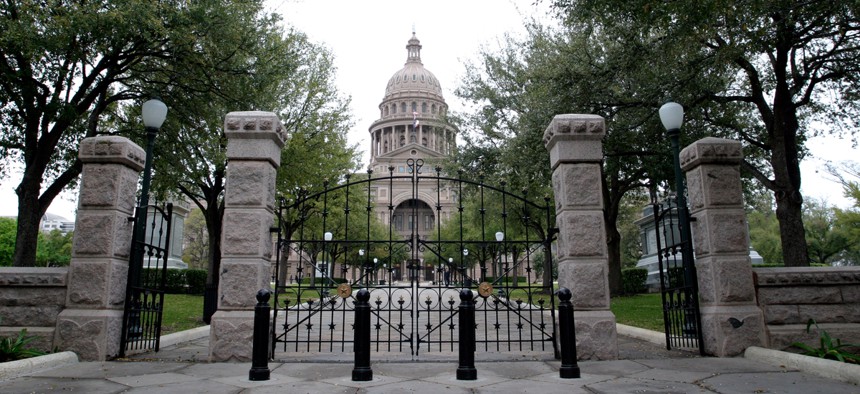Texas Is Building a Killer App for Killing Bureaucracy

The Texas State Capitol in Austin Shutterstock
Chief Information Officer Todd Kimbriel wants a digital assistant to navigate the state’s bureaucracy for citizens.
Todd Kimbriel, Texas’ chief information officer, has a plan to eliminate the aggravation residents can face when trying to figure who they need to deal with in state government.
The problem begins with agencies approaching citizens in a very disjointed fashion, according to Kimbriel. In his view, it can be difficult for agency staff to appreciate what it’s like for a resident to interact with 12 or 15 siloed services, spread across state government.
With this in mind, Kimbriel wants to improve the face of Texas’ bureaucracy, with its 100-plus agencies, via a single, customizable “digital assistant.”
The goal is to put a personalized, citizen-as-customer approach to the entirety of government. The digital assistant would guide citizens through processes, such as registering their car, renewing a hunting or fishing license, helping them navigate social services or benefit programs—and, like a good assistant, sweat the details along the way.
It’s about applying savvy digital relationship management intelligence to the enterprise that is the state of Texas. And, much like our relationships with private companies we interact with in person and online, users will be bothered only at key decision points, or when they choose to be.
“The idea is we want the citizen to be able to consume services in any fashion and form that they choose at any time of day,” Kimbriel told Route Fifty at the National Association of State Chief Information Officers meeting in Baltimore last month.
“We want it to be very personalized,” he added.
For instance, Kimbriel explained, if a user wants a more rural Texas persona, that should be an option. If they want “a more hipster persona from, you know, Rainey Street in Austin,” they should be able to configure that, too. They will also be able to choose to interact with it in a variety of ways, such as email, text message, app or voice directly—think Siri or Alexa.
For Kimbriel, it’s about the state rethinking how services are presented to residents, so they’re not tethered to specific agencies. He recognizes (and, perhaps, hopes) that this will “really force that paradigm shift” within state government that will spur the delivery of services “from a citizen perspective."
Perhaps because it may require a significant culture shift, his agency, the Texas Department of Information Resources, is taking an opt-in approach to the project when it comes to working with other departments and residents.
“We’re not forcing anybody to do anything,” Kimbriel said.
Kimbriel has invited four agencies that “account for a lion’s share of the transactions” on the state website, Texas.gov, to help build the architecture around the digital assistant.
These include: the state’s Parks and Wildlife Department, Department of Licensing and Regulation, Department of Motor Vehicles and Department of Public Safety.
He hopes they will all voluntarily participate in the digital assistant as it takes off.
While he recognizes that state agencies can face resource constraints, he’s optimistic that they will see the value in having a common interaction point with citizens.
Ultimately, he believes citizens will demand change and simplicity. “I think citizen pressure will sort of convince those agencies that may not necessarily think that they want to play to actually come in and join so their services are also delivered through this vehicle,” he said.
Kimbriel expects a demo this fall, and the “first real suite of services” a year later.
The name of the digital assistant is yet to be determined. But Kimbriel has thrown out some ideas. “I’d suggested that perhaps we should call it ‘Texas Online Digital Director,’ which if you do the acronym is T-O-D-D,” Kimbriel said with a smile.
Watch the full interview—and learn more about how data and security fit into Texas’ vision for a personal assistant below:
Why the Future of Data Matters:
“The reality of all of the things we want to do to facilitate this new citizen engagement model really depends upon a unified data ecosystem in the background,” Kimbriel explained. “So one example is, within the app there might be a citizen that has one particular benefit that they take advantage of, and yet, if they take advantage of that benefit there may be three other benefits that they can be taking advantage of—and probably should be—but they may not be aware of that.”
On Security and the Digital Assistant:
“House Bill 8, the cybersecurity bill [passed last session] requires agencies for every single either mobile app or web app to go forward with penetration testing of those apps before they go into production, so that really elevates the status of cybersecurity hygiene for all the solutions that we are putting out in the public.”
Mitch Herckis is Senior Director of Programs for Government Executive’s Route Fifty and is based in Washington, D.C.
NEXT STORY: 17 States Move to Block EPA Weakening of Fuel-Economy Standards






